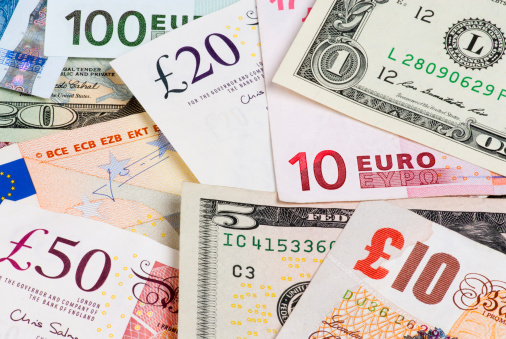A bipartisan deal was reached to end the government shutdown and raise the debt ceiling on Wednesday. While this provides immediate relief, the agreement is only a short reprieve. Funding to the government now ends January 15, and the debt ceiling will only be raised through February 7th.
This follows nearly two weeks of acrimonious debate in the House and Senate which triggered concern in the markets about downgrades by the major credit agencies. In fact, Fitch Ratings warned on Tuesday that it might downgrade U.S. debt amid fears Congress could not find a resolution to raising the debt ceiling. Fitch and Moody’s still assign the U.S. their top ratings (AAA and Aaa respectively); Standard & Poor’s downgraded the U.S. to AA+ in August 2011.
Click here to see the countries with perfect credit
As of October 16, Fitch was alone with its downgrade warning. At the time, S&P spokesman John Piecuch told reporters that the agency’s ratings reflected the potential that a deal could not be struck between Democrats and Republicans. In the last two years, three major countries have lost their top rating from at least one agency: the United States, the United Kingdom and France. In light of the Fitch warning, some have wondered what those few remaining AAA-rated countries have going for them. 24/7 Wall St. examined the 11 countries with perfect AAA ratings from all three ratings agencies.
When determining a country’s debt rating, agencies consider several factors, including the country’s political climate. Most of the countries with AAA ratings have a stable political environment, something the U.S. can no longer exactly claim. Few of these countries have faced the bitter battle that was and may continue to be waged in the U.S. over federal spending and debt.
The countries with the highest credit ratings are wealthy economies, with high levels of GDP per capita. All 11 of these countries are in the top 25 for this figure. Luxembourg, by virtue of its growing financial services industry, generated GDP per capita income of nearly $78,000 2012, 50% greater than in the U.S.
U.S. government gross debt amounted to 102% of GDP in 2012, 11th highest in the world. On Some of the top-rated countries have relatively low debt to GDP, including Australia and Luxembourg, which had debt levels at 27% and 21% of GDP in 2012.
Having low debt to GDP, however, is not necessarily a sign of a stable economy. According to many economists, wealthy, stable countries are able to borrow significantly more than developing nations. For some countries, high debt is a sign of a healthy economy. Five of the AAA-rated countries had debt exceeding 50% of national GDP as of 2012.
To determine the countries that are higher rated than the U.S., 24/7 Wall St. reviewed credit ratings for sovereign countries published by Moody’s, Fitch, and Standard & Poors (S&P). In order to make the cut, nations had to be awarded the highest possible credit rating from each institution– Aaa from Moody’s, or AAA from S&P and Fitch. We excluded countries with very small economies, including the Isle of Man, Guernsey and Liechtenstein. Unemployment rates are from the Organisation for Economic Co-operation and Development, excluding Singapore, while further data on economic activity is largely from the IMF’s World Economic Outlook.
1. Australia
> S&P/Moody’s ratings: AAA/Aaa
> S&P/Moody’s outlook: stable/stable
> 2012 GDP growth: 3.7%
> Unemployment rate: 5.8%
Australia’s AAA rating is based on a solid economy and low government spending. By 2012, the economy had grown by an average of 3.5% a year for more than 20 years. The government debt-to-GDP ratio was 27.9% at the end of 2012, low even among countries that received top ratings from all three agencies. If there’s a vulnerability, it’s that much of the economy is based on exports of natural resources and energy to fast-growing economies, especially China. Growth in the last few years has been stressed by softening conditions in China, but not nearly enough to threaten Australia’s high ratings.
ALSO READ: The Best (and Worst) Countries to Grow Old
2. Canada
> S&P/Moody’s ratings: AAA/Aaa
> S&P/Moody’s outlook: stable/stable
> 2012 GDP growth: 1.7%
> Unemployment rate: 6.9%
Canada’s economy mirrors the U.S. economy. It has a big automotive sector. Technology companies are growing in and around Vancouver and Toronto. It is the largest supplier of energy to the U.S., including oil, natural gas, uranium and hydroelectricity. In all, roughly three quarters of Canadian exports go to the U.S. The country was hit hard by the 2008-2009 recession, first with its automotive sector slumping and then with declining commodity prices, especially oil. Canadian banks, however, largely weathered the economic storm. Also, recent rising oil prices and exports to the U.S. have boosted the economy.
3. Denmark
> S&P/Moody’s ratings: AAA/Aaa
> S&P/Moody’s outlook: stable/stable
> 2012 GDP growth: -0.4%
> Unemployment rate: 6.6%
Denmark’s finances are in solid shape, despite after-effects from the 2008-2009 financial crisis and the eurozone crisis. Government debt is 59% of GDP, higher than any other AAA rated economy. Denmark has considerable strengths, including a vibrant maritime industry and a strong pharmaceutical industry. Unemployment, however, remains relatively high at 6.6%, but the rate has come down slowly from 7.4% 12 months earlier.
4. Finland
> S&P/Moody’s ratings: AAA/Aaa
> S&P/Moody’s outlook: stable/stable
> 2012 GDP growth: -0.8%
> Unemployment rate: 8.0%
Finland became an economic star in the 1990s and the first part of the 21st century because of rapid growth in technology and telecommunications. Nokia contributed a quarter of the country’s growth and paid as much as 23% of Finnish corporate income taxes by itself between 1998 and 2007, according to The Economist. But the recession and the eurozone crisis have hurt the economy. Perhaps worse has been Nokia’s decline in the face of Apple’s ascendancy.
5. Germany
> S&P/Moody’s ratings: AAA/Aaa
> S&P/Moody’s outlook: stable/negative
> 2012 GDP growth: 0.9%
> Unemployment rate: 5.2%
The last few years have not been easy for Germany because of the ongoing struggles of eurozone nations such as Greece, Cyprus, Ireland, Spain, Portugal, and Italy. However, many economists believe the worst of Europe’s economic troubles are over. That should help Germany’s exports, which are already equivalent to more than 51% of total GDP. While Moody’s says the German government finances are in good shape, the ratings agency maintains a negative outlook on German debt because of all the contingent liabilities the country assumed keeping the eurozone afloat.
6. Luxembourg
> S&P/Moody’s ratings: AAA/Aaa
> S&P/Moody’s outlook: stable/negative
> 2012 GDP growth: 0.3%
> Unemployment rate: 5.8%
Three factors help Luxembourg’s credit rating: it’s close to France, Germany, and Belgium; it has a diversified economy; and its financial sector has helped insure that its per capita incomes are among the world’s highest. Luxembourg suffered from the 2008 financial crisis and slowdown prompted by the debt problems elsewhere in the eurozone. The nation’s GDP fell by 0.7% in 2008, and then by an additional 4.1% in 2009.
7. The Netherlands
> S&P/Moody’s ratings: AAA/Aaa
> S&P/Moody’s outlook: negative/negative
> 2012 GDP growth: -1.2%
> Unemployment rate: 4.9%
As the year began, weakness in Dutch banks and the broader Dutch economy threatened the Netherlands’ AAA rating. All three ratings agencies continue to rate Netherlands’ outlook as negative. Fitch cited sagging home prices and worsening public debt picture as reasons for the negative outlook. After a housing boom-and-bust, some 25% of mortgages in the country are underwater, Fitch says. Still, the country has the eurozone’s fifth largest economy.
ALSO READ: The Most Educated Countries in the World
8. Norway
> S&P/Moody’s ratings: AAA/Aaa
> S&P/Moody’s outlook: stable/stable
> 2012 GDP growth: 3.0%
> Unemployment rate: 3.6%
Lucky Norway. It has a small population and abundant reserves of crude oil lying under the North Sea. The country’s unemployment rate is among the lowest in Europe. Norway offers its citizens a generous set of social benefits. Its sovereign wealth fund has nearly $800 billion in assets and is the world’s largest. Because of its oil reserves, Norway’s government was able to spend around 43% of GDP in 2012, yet still have a total debt obligation equal to just 34% GDP. Only Luxembourg and Australia have less government debt as a percentage of GDP among the AAA-rated countries. No wonder that S&P and Moody’s see Norway as a AAA credit and stable.
9.Singapore
> S&P/Moody’s ratings: AAA/Aaa
> S&P/Moody’s outlook: stable/stable
> 2012 GDP growth: 1.3%
> Unemployment rate: 2.1%
Singapore is one of the most business-friendly countries in the world, according to the World Bank. It’s the only country in southeast Asia with a AAA rating from all three agencies. The island nation of 5.3 million people, is a transportation hub, a technology center, and an important banking center. It’s also jobs friendly with an unemployment rate of just 2.1%. However the country is restricted by its small land size, and has to expand its actual land area through reclamation.
10. Sweden
> S&P/Moody’s ratings: AAA/Aaa
> S&P/Moody’s outlook: stable/stable
> 2012 GDP growth: 1.0%
> Unemployment rate: 8.0%
Sweden’s unemployment rate is relatively high at 8%, but its strong overall fiscal management keeps impressing ratings agencies. Public debt, which was as high as 73.3% of GDP in 1996, dropped to 38% at the end of 2012. Like just about every European country, Sweden was staggered by the 2008 financial crisis and the eurozone debt crisis later. But the economy has been recovering, albeit slowly.
ALSO READ: Countries with the most Multimillionaires
11. Switzerland
> S&P/Moody’s ratings: AAA/Aaa
> S&P/Moody’s outlook: stable/stable
> 2012 GDP growth: 1.0%
> Unemployment rate: 4.2%
Switzerland is a model of consistency. Government spending runs at just about 33% of GDP year after year. Government debt-to-GDP ratio is just under 50% year after year. It is a very prosperous country built around its financial services industry (UBS and Credit Suisse), its big drug and food companies (Novartis and Nestle), its transparent legal system, its advanced transportation network and, of course, the scenery. But its prosperity and stability can also be a problem. The Swiss franc has appreciated by 22.5% against the euro and 24.5% against the U.S. dollar over the last five years. 44% against the U.S. dollar since the end of 2005 and 36% against the euro since a low in 2007. That threatened important Swiss exports — such as watches, scientific instruments and the like — and forced the Swiss to intervene to drive the franc lower in 2011.
Travel Cards Are Getting Too Good To Ignore (sponsored)
Credit card companies are pulling out all the stops, with the issuers are offering insane travel rewards and perks.
We’re talking huge sign-up bonuses, points on every purchase, and benefits like lounge access, travel credits, and free hotel nights. For travelers, these rewards can add up to thousands of dollars in flights, upgrades, and luxury experiences every year.
It’s like getting paid to travel — and it’s available to qualified borrowers who know where to look.
We’ve rounded up some of the best travel credit cards on the market. Click here to see the list. Don’t miss these offers — they won’t be this good forever.
Thank you for reading! Have some feedback for us?
Contact the 24/7 Wall St. editorial team.


